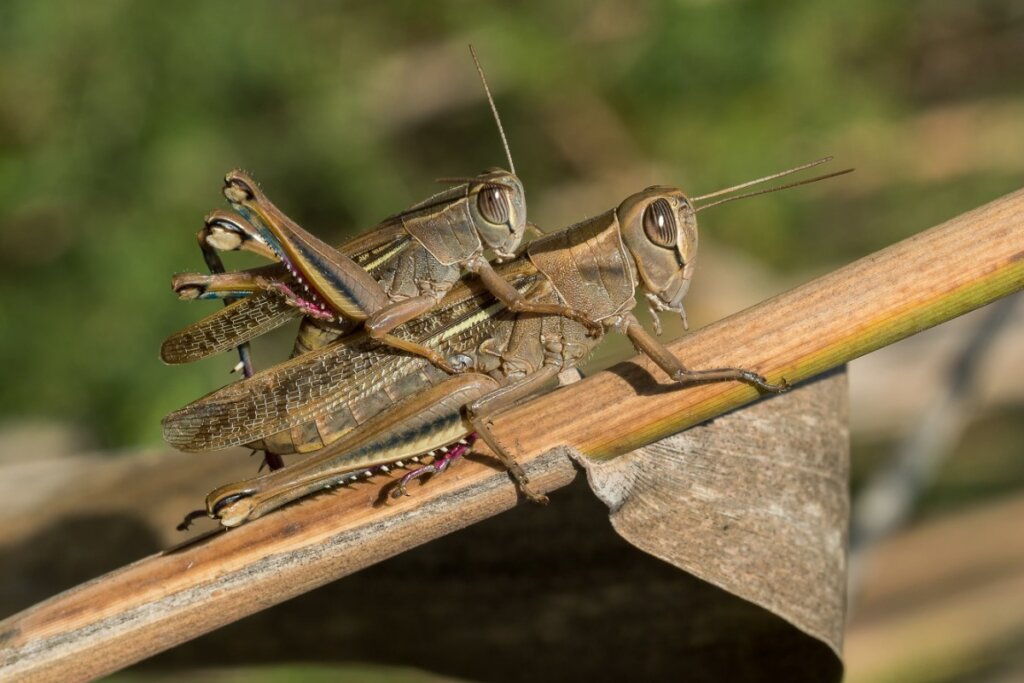The Differences Between Grasshoppers and Locusts
Although both terms are often used interchangeably, grasshoppers and locusts have several differences from a general point of view. Although this distinction isn’t very useful at a phylogenetic level, it is useful when we want to differentiate the life cycles of some of the most fascinating invertebrates on Earth. The key is found in the immigration behavior of one of them.
Grasshoppers and locusts are Orthoptera, an order of insects that includes some 20,000 species and also includes crickets. Next, we’ll show you the differences and similarities between them. Keep reading, because the way these animals live is sure to fascinate you.
What are grasshoppers and locusts?
First of all, it’s necessary to emphasize that both grasshoppers and locusts are Orthoptera insects. This means that they meet a series of common morphological requirements in all members of their order: a round head with lateralized antennae and eyes, a thorax with 3 pairs of legs (the last ones for jumping), an abdomen with 11 segments, and wings that enable them to fly.
In addition to belonging to the Orthoptera order, the invertebrates that concern us here are part of the Caelifera suborder. This grouping encompasses all animals with the body shape of a grasshopper, other than a mole cricket (which belongs to the family Gryllotalpidae). For this reason, in the strict sense of the term, a locust is a type of grasshopper.
So, locusts are grasshoppers, but not all grasshoppers have the life cycle of locusts. Therefore, rather than differentiating both terms in isolation, we find it more interesting to compare typical species within each of the groups. Since they all belong to the same order, suborder and family, it is necessary to choose specific examples.
We’ve chosen Schistocerca americana and Omocestus viridulus from the group of grasshoppers, and Locusta migratoria from the group of locusts, as this is the most famous. Next up, we’ll show you their biological differences.
Lobsters belong to the suborder Caelifera and the Acrididea family, so, by definition, they’re grasshoppers.
1. Locusts are larger than common grasshoppers.
The initial difference between grasshoppers and locusts is that the latter tend to be larger. However, the species of common American grasshopper (Schistocerca americana) reaches 5.5 centimeters (2.2 inches) in length in its adult stage, and, in the case of females, European specimens such as Omocestus viridulus rarely exceed 2 centimeters (0.8 inches) in wingspan.
In general, a grasshopper measures 2 to 3 centimeters in length (0.8 to 1.2 inches), while the Locusta migratoria lobster reaches 6 centimeters (2.4 inches) in the case of an adult female. Thus, we can say that, generally, locusts are a little larger than the rest of their relatives.
2. Morphology may differ depending on the species
Grasshoppers come in all possible shapes and colors: green, yellow with reddish wings, dark brown, and others that have intermediate patterns between these tones. Some show highly differentiated ovipositors and have a leaf shape for camouflage, as is the case of the longicorn grasshoppers of the Tettigoniidae family.
On the other hand, the term “locust” is applied to very few species (about 30, including L. migratoria), so their body shape is usually quite homogeneous. They have developed wings, brownish-green colors, and certain grainy patterns along their body. Females are always larger than males.
It’s possible to distinguish a grasshopper from a locust on a physical level, but there’s so much variety in the first group that it’s easy to make a mistake.
3. Locusts migrate, grasshoppers don’t
Strictly speaking, the only attribute that truly differentiates between the grasshopper and the locust is their migratory capacity. The physical characteristics and size may tell us something, but if we consider that there are more than 11,000 species in the Caelifera group, it’s easy to see how many grasshoppers will be extremely similar to a locust.
At least 25 species within the grasshopper group do migrate, which classifies them as locusts. The main ones are Chortoicetes terminifera, Austracris guttulosa and Locusta migratoria. These insects are solitary in normal times, but when certain environmental conditions occur they form gregarious flocks.
The phase shift between being alone and accompanied is determined by DNA methylation in the brain. Simply put, the Dnmt3 gene is expressed much more in the gregarious form, while its activity appears to decrease when locusts are alone.
Locust armies destroy all vegetation in their path. There may be 80 million of them per square kilometer.
4. Locusts are capable of changing according to their phase
Grasshoppers follow a normal growth pattern (they’re born as mobile nymphs and molt many times until they become adults), but locusts don’t. In the latter, apart from the phase of their biological cycle they find themselves in, migration plays an essential role in their physical appearance.
Lonely phase locusts are somewhat larger and greener in order to blend in with the surrounding vegetation. On the other hand, gregarious ones have a reduced bearing and a striking yellow color interspersed with brown tones. Thus, these invertebrates have two appearances (phenotypes) according to their life strategy.
It may all seem rather confusing, but, in summary, locusts are a type of grasshopper, but not all grasshoppers are locusts! Only those capable of migrating and changing their phenotype according to their phase are considered locusts as such.
It might interest you...All cited sources were thoroughly reviewed by our team to ensure their quality, reliability, currency, and validity. The bibliography of this article was considered reliable and of academic or scientific accuracy.
- Chapman, R. F., & Joern, A. (Eds.). (1990). Biology of grasshoppers. John Wiley & Sons.
- Marshall, J. A., & Haes, E. C. M. (1988). Grasshoppers and allied insects of Great Britain and Ireland. Harley Books.
- Rentz, D. C. (1996). Grasshopper country: the abundant orthopteroid insects of Australia. UNSW Press.
- Friedrich, M. (2003). Evolution of insect eye development: first insights from fruit fly, grasshopper and flour beetle. Integrative and comparative biology, 43(4), 508-521.
